Hispanic and Latino conservatism in the United States
Hispanic and Latino Americans make up an increasing share of the United States (U.S.) electorate. A record 29 million Latinos were eligible to vote in the 2018 midterm elections, accounting for 12.8% of all eligible voters, a new high. Latinos made up an estimated 11% of all voters nationwide on Election Day, nearly matching their share of the U.S. eligible voter population (U.S. citizens ages 18 and older).[1]
Hispanic/Latino Participation and Key Issues
The U.S. Census indicates that the Latino population of the U.S. is the fastest growing minority group in the country.[2] More than 12.8% of eligible voters nationwide are Latino.[3]
In the 2018 midterm elections, three out of four Latino voters supported a Democratic candidate.[4] However, Republicans enjoy strong support among Cuban-American and Venezuelan-American voters,[5] as well as among Latino voters in Florida and Texas.[6] Mexican-Americans, Puerto Ricans, Salvadoran-Americans, Guatemalan-Americans, and Dominican-Americans tend to support the Democratic Party. As the latter groups are far more numerous (Mexican-Americans alone are 64% of American Latinos),[7] the Democratic Party typically receives the majority of the Latino vote.
Although Latinos, as a whole, tend to support Democratic candidates, the Democratic Party has lost ground among Latino voters since its high-water mark in 2012.[8]
In 2006, 69% of Latino voters supported Democratic candidates in congressional races, while 30% supported Republican candidates.
In 2008, 67% of Latinos voted for Democratic presidential nominee Barack Obama, while 31% of Latinos voted for Republican presidential nominee John McCain.[9]
During the 2010 midterm elections, 31% of eligible Latino voters turned out to vote.[10] 60% of Latinos supported Democratic candidates, while 38% supported Republican candidates.[11] According to an October 2010 Pew Hispanic Center report, Hispanics ranked education, jobs, and health care as their top three issues of concern. Immigration ranked as the fourth most important issue for all Latinos.[12]
A 2012 study by the Center for Immigration Studies projected that in November 2012 Latinos would comprise 17.2% of the total U.S. population, 15% of adults, 11.2% of adult citizens, and 8.9% of voters. By comparison, the report found that in 2012, non-Latino whites are expected to be 73.4% of the national vote and non-Latino blacks are expected to be 12.2%. The report noted that by weight, "eight percentage points of the Hispanic vote nationally equals slightly less than one percentage point of the non-Hispanic white vote." The study also compared the 8.9% Latino share of voters to veterans (12% of the electorate), those with family incomes above $100,000 (18%), seniors 65 and older (19%), married persons (60%), and those who live in owner-occupied housing (80%).[13]
In terms of voter turnout, the Center for Immigration Studies projected that 52.7% (± 0.6) of eligible Latinos would vote in the 2012 election, an increase from 49.9% in 2008 and a continuation of the past decade's long upward trend. The projected Latino voter participation rate of 52.7% compares to 66.1% for non-Latino whites and 65.2% for non-Latino blacks in 2008.[13]
In 2012, 70% of Latino voters identified with, or leaned toward, the Democratic Party, while 20% of Latino voters identified with, or leaned toward, the Republican Party.[14]
In 2014, Latinos cast 6.8 million ballots out of 25 million eligible voters, for a voter turnout rate of 27%.[15]
During the 2016 Presidential Election, Republican presidential nominee Donald Trump was supported by 57% of Cuban-American voters in Florida, while Democratic presidential nominee Hillary Clinton received 40% of the vote.[16]
In 2018, 29.1 million Latino's were eligible to vote. 62% of Latino voters identified with, or leaned toward, the Democratic Party, whereas 27% of Latino voters identified with, or leaned toward, the Republican Party. Latino voters who primarily spoke English were more likely to support Republican candidates (33%), compared to voters who only spoke Spanish (15%).[17] In Florida, 66% of Latino's supported Republican gubernatorial nominee Ron DeSantis, while only 33% supported Democrat gubernatorial nominee Andrew Gillum, a 2 to 1 ratio for Republicans.[18]
According to a 2019 Gallup Poll, 29% of Latinos identify as Conservative, and that same number, 29%, voted for Donald Trump in the 2016 Presidential Election. [19]
Timeline of events

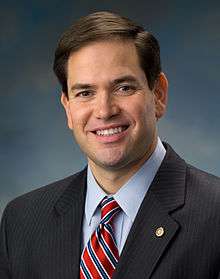
.jpg)


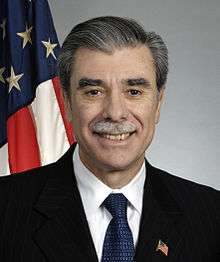
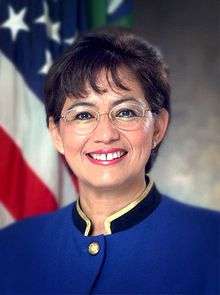
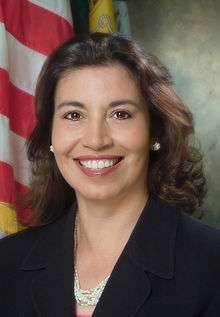
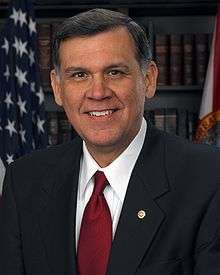
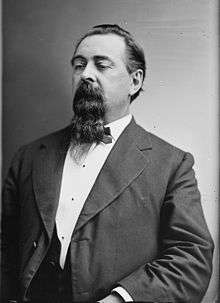
This is a timeline of significant events in Hispanic history which have shaped the conservative movement in the United States.
- 1860s
- 1863 - Romualdo Pacheco elected as California State Treasurer
- Francisco Perea (New Mexico Territory) elected to U.S. Congress (non voting delegate)
- 1865 - José Francisco Chaves (New Mexico Territory) elected to U.S. Congress (non voting delegate)
- 1870s
- 1871 - Romualdo Pacheco elected as Lieutenant Governor of California
- 1875 - Romualdo Pacheco appointed as Governor of California
- 1877 - Romualdo Pacheco (CA) elected to U.S. Congress and Trinidad Romero (New Mexico Territory) elected to U.S. Congress (non voting delegate)
- 1879 - Mariano S. Otero (New Mexico Territory) elected to U.S. Congress (non voting delegate)
- 1880s
- 1881 - Tranquilino Luna (New Mexico Territory) elected to U.S. Congress (non voting delegate)
- 1890s
- 1897 - Miguel Antonio Otero elected as Governor of New Mexico Territory
- 1899 - Pedro Perea (New Mexico Territory) elected to U.S. Congress (non voting delegate)
- 1900s
- 1901 - Federico Degetau elected to U.S. Congress (1st Resident Commissioner of Puerto Rico)
- 1905 - Tulio Larrínaga elected to U.S. Congress (1st Resident Commissioner of Puerto Rico)
- 1910s
- 1911 - Luis Muñoz Rivera elected to U.S. Congress (1st Resident Commissioner of Puerto Rico)
- 1917 - Félix Córdova Dávila (Resident Commissioner of Puerto Rico) and Benigno C. Hernández (NM) elected to U.S. Congress
- 1919 - Octaviano Ambrosio Larrazolo elected as Governor of New Mexico
- 1920s
- 1921 - Néstor Montoya (NM) elected to U.S. Congress
- 1928 - Octaviano Ambrosio Larrazolo elected as United States Senator from New Mexico
- 1960s
- 1967 - Ben Fernandez creates the Republican National Hispanic Assembly
- 1969 - Luis A. Ferré elected as Governor of the Commonwealth of Puerto Rico
- Jorge Luis Córdova (Resident Commissioner of Puerto Rico) and Manuel Lujan, Jr. (NM) elected to U.S. Congress
- 1970s
- 1971 - President Richard M. Nixon appoints Romana Acosta Bañuelos as Treasurer of the United States
- 1973 - President Richard M. Nixon appoints Ben Fernandez as Ambassador to Paraguay
- 1977 - Baltasar Corrada del Río elected to U.S. Congress (Resident Commissioner of Puerto Rico)
- 1979 - Mike Curb elected as Lieutenant Governor of California
- 1980s
- 1981 - President Ronald Reagan appoints John Gavin as United States Ambassador to Mexico
- 1983 - President Ronald Reagan appoints Katherine D. Ortega as Treasurer of the United States
- Barbara Vucanovich (NV) is elected to U.S. Congress
- Patricia Dillon Cafferata is elected Nevada State Treasurer
- Barbara Vucanovich (NV) is elected to U.S. Congress
- 1985 - President Ronald Reagan appoints Linda Chavez as Assistant to the President for Public Liaison
- 1987 - Bob Martinez elected as Governor of Florida
- 1989 - President George H. W. Bush appoints Manuel Lujan, Jr. as United States Secretary of the Interior
- Ileana Ros-Lehtinen (FL) is elected to U.S. Congress
- 1990s
- 1990 - President George H. W. Bush appoints Vice Admiral Dr. Antonia Novello as Surgeon General of the United States
- 1991 - President George H. W. Bush appoints Bob Martínez as Director of the National Drug Control Policy
- 1993 - Henry Bonilla (TX) and Lincoln Díaz-Balart (FL) elected to U.S. Congress
- 1995 - Tony Garza appointed Texas Secretary of State
- 1997 - John E. Sununu (NH) is elected to U.S. Congress
- Alberto Gonzales appointed Texas Secretary of State
- 1999 - Alberto Gonzales elected as Associate Justice of the Texas Supreme Court
- 2000s
- 2000 - Matthew G. Martinez (CA) Democratic Congressman joins GOP
- 2001 - President George W. Bush appoints the following:
- Hector Barreto as Administrator of the Small Business Administration
- Rosario Marin as Treasurer of the United States
- Mel Martínez as United States Secretary of Housing and Urban Development
- Alberto Gonzales as White House Counsel
- Elsa Murano as Under Secretary of Agriculture for Food Safety
- Leslie Sanchez as Executive Director, White House Initiative on Educational Excellence for Hispanic Americans
- Cari M. Dominguez as Chair of the Equal Employment Opportunity Commission
- Major General William A. Navas, Jr. as Assistant Secretary of the Navy (Manpower and Reserve Affairs)
- Michael Montelongo as Assistant Secretary of the Air Force (Financial Management & Comptroller)
- Alberto J. Mora as General Counsel of the Navy
- Michael L. Dominguez as Assistant Secretary of the Air Force (Manpower & Reserve Affairs)
- Dionel M. Aviles as Assistant Secretary of the Navy (Financial Management and Comptroller)
- Israel Hernandez as Assistant Secretary of Commerce for International Trade and Promotion
- Douglas Domenech as Deputy Director of the Office of External and Intergovernmental Affairs in the United States Department of the Interior
- Colonel Dr. Jacob Lozada as Assistant Secretary of Veterans Affairs
- Ruben Barrales as Director of Intergovermental Affairs in the White House
- Leslie Sanchez as Director of the White House Initiative on Educational Excellence for Hispanic Americans
- Jaime Molera is appointed Arizona Superintendent of Public Instruction
- 2002 - President George W. Bush appoints the following:
- Tony Garza as United States Ambassador to Mexico
- Michael J. Garcia as Commissioner of the Immigration and Naturalization Service
- 2003 - President George W. Bush appoints the following:
- Roger Noriega as Assistant Secretary of State for Western Hemisphere Affairs
- Rear Admiral Dr. Cristina V. Beato as United States Assistant Secretary for Health
- Colonel Dr. Jacob Lozada as Human Resource Agencys Special Advisor to the Director of OPM for Diversity Strategy
- Alex Acosta as Assistant Attorney General for Civil Rights
- Mario Díaz-Balart (FL) elected to U.S. Congress
- Texas Attorney General Greg Abbott appoints Ted Cruz as Solicitor General of Texas
- Brian Sandoval elected as Attorney General of Nevada
- John E. Sununu elected as United States Senator from New Hampshire
- Brian Sandoval elected as Attorney General of Nevada
- Texas Attorney General Greg Abbott appoints Ted Cruz as Solicitor General of Texas
- Mario Díaz-Balart (FL) elected to U.S. Congress
- 2004 - President George W. Bush appoints Dionel M. Aviles as Under Secretary of the Navy
- 2005 - President George W. Bush appoints the following:
- Alberto Gonzales as United States Attorney General
- Carlos Gutierrez as United States Secretary of Commerce
- Anna Escobedo Cabral as Treasurer of the United States
- Michael L. Dominguez as acting United States Secretary of the Air Force
- Emilio T. Gonzalez as Director of United States Citizenship and Immigration Services (USCIS)
- Israel Hernandez as Assistant Secretary of Commerce for International Trade and Promotion and Director-General of the United States Commercial Service
- Alfonso Martinez-Fonts Jr. as Assistant Secretary for the Private Sector Office at the United States Department of Homeland Security
- Juan Zarate as Deputy Assistant to the President and Deputy National Security Advisor for Combating Terrorism
- Raymond P. Martinez as Deputy Chief of Protocol of the United States
- Eduardo Aguirre as United States Ambassador to Spain
- Mel Martínez elected as United States Senator from Florida
- Luis Fortuño elected to U.S. Congress (Resident Commissioner of Puerto Rico)
- Mel Martínez elected as United States Senator from Florida
- 2006 - President George W. Bush appoints the following:
- Hugo Teufel III as Chief Privacy Officer, Department of Homeland Security
- Lisette M. Mondello as Assistant Secretary of Public and Intergovernmental Affairs in the Department of Veterans Affairs
- Nancy Montanez Johner as Under Secretary of Agriculture for Food, Nutrition, and Consumer Services
- Frank Jimenez as General Counsel of the Navy
- 2007 - President George W. Bush appoints Christopher A. Padilla as Under Secretary for International Trade
- 2008 - President George W. Bush appoints Admiral Joxel García as United States Assistant Secretary for Health
- Esperanza Andrade appointed Texas Secretary of State
- 2009 - Luis Fortuño elected as Governor of Puerto Rico
- 2010s
- 2010 - Abel Maldonado appointed Lieutenant Governor of California
- 2011 - Marco Rubio elected as United States Senator from Florida
- Quico Canseco (TX), Bill Flores (TX), Jaime Herrera Beutler (WA), Raúl Labrador (ID) and David Rivera (FL) elected to U.S. Congress
- Susana Martinez elected as Governor of New Mexico and Brian Sandoval elected as Governor of Nevada
- John Sanchez elected as Lieutenant Governor of New Mexico
- Susana Martinez elected as Governor of New Mexico and Brian Sandoval elected as Governor of Nevada
- Quico Canseco (TX), Bill Flores (TX), Jaime Herrera Beutler (WA), Raúl Labrador (ID) and David Rivera (FL) elected to U.S. Congress
- 2013 - Ted Cruz elected as United States Senator from Texas
- Ron DeSantis (FL) elected to U.S. Congress
- Sean Reyes appointed Utah Attorney General
- Ron DeSantis (FL) elected to U.S. Congress
- 2014 - Carlos López-Cantera appointed as Lieutenant Governor of Florida
- Carlos Curbelo (FL) & Alex Mooney (WV) elected to U.S. Congress
- Evelyn Sanguinetti elected as Lieutenant Governor of Illinois
- George P. Bush elected as Texas Commissioner of the General Land Office
- Evelyn Sanguinetti elected as Lieutenant Governor of Illinois
- Carlos Curbelo (FL) & Alex Mooney (WV) elected to U.S. Congress
- 2015 - Carlos Cascos appointed as Texas Secretary of State
- Joe Baca, former Democratic U.S. Representative for California joins GOP
- 2016 - Jenniffer González elected as Resident Commissioner of Puerto Rico and Brian Mast (FL) elected to U.S. Congress
- 2017 - President Donald Trump appoints the following:
- Alexander Acosta as United States Secretary of Labor
- Helen Aguirre Ferré as White House Director of Media Affairs
- Jovita Carranza as Treasurer of the United States
- Anna Maria Farias as Assistant Secretary of Housing and Urban Development for Fair Housing and Equal Opportunity
- Douglas Domenech as Assistant United States Secretary of the Interior for Insular Affairs
- Mercedes Schlapp as White House Director of Strategic Communications
- José A. Viana as Director of the Office of English Language Acquisition
- Carlos Trujillo as United States Ambassador to the Organization of American States
- Chris Garcia as Director of the Minority Business Development Agency
- Jennifer S. Korn as Deputy Director of the Office of Public Liaison
- Brian Quintenz as Member of the Commodity Futures Trading Commission
- Rolando Pablos appointed as Texas Secretary of State
- Dave Lopez appointed as Secretary of State of Oklahoma
- Rolando Pablos appointed as Texas Secretary of State
- 2018 - President Donald Trump appoints the following:
- Edward C. Prado - United States Ambassador to Argentina
- Raymond P. Martinez as Administrator of the Federal Motor Carrier Safety Administration
- James E Campos as Director of the Office of Minority Economic Impact
- Anthony Gonzalez (OH) elected to U.S. Congress
Politicians
Alaska
- Liz Vazquez - Alaska State Representative (2015–2017)
Arizona
- Steve Montenegro - Arizona State Representative (2009–2017) & Arizona State Senator (2017)
- T. J. Shope - Arizona State Representative (2013–present)
- Tony Rivero - Arizona State Representative (2015–present)
Arkansas
- Justin Gonzales - Arkansas State Representative (2015–present)
- Jim Sorvillo - Arkansas State Representative (2015–present)
California
- Rod Pacheco - California State Assemblyman (1996-2002) and Riverside County District Attorney (2007-2011)
- Bob Pacheco - California State Assemblyman (1998-2004)
- Bonnie Garcia - California State Assemblywoman (2002-2008)
- Rocky Chavez - California State Assemblyman (2012–2018)
- Eric Linder - California State Assemblyman (2012–2016)
- Melissa Melendez - California State Assemblywoman (2012–present)
- Heath Flora - California State Assemblyman (2016–present)
- Dante Acosta - California State Assemblyman (2016–2018)
Colorado
- Philip Covarrubias - Colorado State Representative (2017–2019)
- Beth Martinez Humenik - Colorado State Senator (2015–2019)
- Clarice Navarro - Colorado State Representative (2013–2017)
- George Rivera - Colorado State Senator (2013–2015)
- Robert Ramirez - Colorado State Representative (2011-2013)
- Stella Garza-Hicks - Colorado State Representative (2007-2009)
- Lionel Rivera - Mayors of Colorado Springs (2003-2011)
Connecticut
- Aundre Bumgardner – Connecticut State Representative (2015-2017)
- Art Linares - Connecticut State Senator (2013–2019)
Delaware
- Ernesto Lopez - Delaware Senator (2012–present)
- Joseph Miró - Delaware State Representative (1998–2018)
Florida
- Humberto Cortina - Florida State Representative (1982-1984)
- Javier Souto - Florida State Senator (1984-1992)
- Al Guzman - Florida State Representative (1984-1992) and Florida State Senator (1992–1998)
- Arnhilda Gonzalez-Quevedo - Florida State Representative (1984-1988)
- Luis E. Rojas - Florida State Representative (1988-1998)
- Carlos L. Valdez - Florida State Representative (1988-1996)
- Carlos A. Manrique - Florida State Representative (1992-1994)
- Eladio Armesto-Garcia - Florida State Representative (1992-1994)
- Bruno Barreiro - Florida State Representative (1992-1998)
- Carlos A. Lacasa - Florida State Representative (1994-2002)
- Gustavo Barreiro - Florida State Representative (1996-2008)
- Gaston Cantens - Florida State Representative (1996-2004)
- Al Cardenas - Chairman of the Republican Party of Florida (1999-2003)
- Rafeal Arza - Florida State Representative (2000-2006)
- Alex Diaz de la Portilla - Florida State Senator (2000-2010)
- Rene Garcia - Florida State Representative (2000-2010) and Florida State Senator (2010–present)
- Rudy Garcia - Florida State Senator (2000-2010)
- Carlos A. Giménez - Chief of the Miami Fire Department (2000-2003), Miami-Dade County Commissioner (2004-2011) and Mayor of Miami-Dade County (2011-present)
- Joe Negron - Florida State Representative (2000-2006) and Florida State Senator (2009–present)
- J. Alex Villalobos - Florida State Senator (2001-2010)
- Carl J. Domino - Florida State Representative (2002-2010) and U.S. House nominee (2014)
- Marcelo Llorente - Florida State Representative (2002-2010)
- Juan-Carlos Planas - Florida State Representative (2002-2010)
- John Quiñones - Florida State Representative (2002-2007), Miami-Dade County Commission (2007-present) and U.S. House Candidate (2012)
- Juan C. Zapata - Florida State Representative (2002-2010)
- Anitere Flores - Florida State Representative (2004-2010) and Florida State Senator (2010–present)
- Julio Robaina - Mayor of Hialeah (2005-2011)
- Eduardo González - Florida State Representative (2006–present)
- Esteban Bovo - Florida State Representative (2008-2010) and Miami-Dade County Commission (2011–present)
- Erik Fresen - Florida State Representative (2008–2016)
- Tomás Regalado - Mayor of Miami (2009–2017)
- Fred Costello - Florida State Representative (2010-2012 & 2014–2016) and U.S. House Candidate (2012)
- Frank Artiles - Florida State Representative (2010–2016) & Florida State Senator (2016-2017)
- Miguel Diaz de la Portilla - Florida State Senator (2010–2016)
- Jose Felix Diaz - Florida State Representative (2010–2017)
- Jeanette Núñez - Florida State Representative (2010–2018) & Lt Governor of Florida (2019-present)
- Ana Rivas Logan - Florida State Representative (2010-2012)
- Carlos Trujillo - Florida State Representative (2010–2018)
- Jose R. Oliva - Florida Speaker of the House (2019-)
- Carlos Hernandez - Mayor of Hialeah, Florida (2011–present)
- Mike La Rosa - Florida State Representative (2012–present)
- Manny Díaz, Jr. - Florida State Representative (2012–2018) & Florida State Senator (2018-present)
- Ray Rodrigues - Florida State Representative (2012–present)
- David Santiago - Florida State Representative (2012–present)
- Bob Cortes - Florida State Representative (2014–2018)
- Rene Plasencia - Florida State Representative (2014–present)
- Julio Gonzalez - Florida State Representative (2014–present)
- Bryan Avila - Florida State Representative (2014–present)
- Jackie Toledo - Florida State Representative (2016–present)
- Daniel Anthony Perez - Florida State Representative (2017–present)
- Francis X. Suarez - Mayor of Miami (2017–present)
- Ana Maria Rodriguez - Florida State Representative (2018–present)
- Anthony Rodriguez - Florida State Representative (2018–present)
- Juan Fernandez-Barquin - Florida State Representative (2018–present)
Georgia
- Steven Sainz - Georgia State Representative (2019-present)
- David Casas - Georgia State Representative (2003-2019)
Hawaii
- Joseph R. Garcia, Jr. - Hawaii State Representative (1959-1974)
Illinois
- Frank Aguilar - Illinois State Representative (2002-2004)
- John Cabello - Illinois State Representative (2012–present)
Indiana
- Rebecca Kubacki - Indiana State Representative (2010-2014)
Iowa
- Mark Costello - Iowa State Representative (2012–present)
Kansas
- Ramon Gonzalez Jr. - Kansas State Representative (2011-2017)
- Mario Goico - Kansas State Representative (2003-2017)
- Carlos Mayans - Mayor of Wichita, Kansas (2003-2007)
Kentucky
- Ralph Alvarado - Kentucky State Senator (2015–present)
Louisiana
- Blake Miguez - Louisiana State Representative (2015–present)
Massachusetts
- Gabriel E. Gomez - Republican nominee for the U.S. Senate in the 2013 special election in Massachusetts
Michigan
- Shane Hernandez - Michigan State Representative (2017-present)
- Daniela Garcia - Michigan State Representative (2015–2019)
Minnesota
- Eric Lucero - Minnesota State Representative (2015-present)
- Jon Koznick - Minnesota State Representative (2015-present)
Missouri
- Robert Cornejo - Missouri State Representative (2013–present)
Nebraska
- Ray Aguilar - Member of the Nebraska Legislature (1999-2008)
Nevada
- Victoria Seaman - Nevada State Assemblywoman (2015–2017) & Las Vegas City Councillor (2019-present)
New Hampshire
- Marilinda Garcia - New Hampshire State Representative (2006–2014) & U.S. House nominee (2014)
- Carlos Gonzalez - New Hampshire State Representative (2010–2012 & 2014-2016)[20]
- Bianca Garcia - New Hampshire State Representative (2012–2014)
- Eric Estevez - New Hampshire State Representative (2014–2016)
- Steve Negron - New Hampshire State Representative (2016–2018) & U.S. House nominee (2018)
New Jersey
- José F. Sosa - New Jersey Assemblyman (1992-1994)
- Eric Munoz - New Jersey Assemblyman (2001-2009)
- Maria Rodriguez-Gregg - New Jersey Assemblywoman (2014–2018)
New Mexico
- Larry Larrañaga - New Mexico State Representative (1995–present)
- Nora Espinoza - New Mexico State Representative (2007–2017)
- Alonzo Baldonado - New Mexico State Representative (2011–present)
- David Chavez - New Mexico State Representative (2011–2013)
- Kelly Fajardo - New Mexico State Representative (2013–present)
- David Gallegos - New Mexico State Representative (2013–present)
- Paul Pacheco - New Mexico State Representative (2013–2017)
- Vickie Perea - New Mexico State Representative (2013–2015)
- Monica Youngblood - New Mexico State Representative (2013–2019)
- Lisa Torraco - New Mexico State Senator (2013–2017)
- Sarah Maestas Barnes - New Mexico State Representative (2015–2019)
- Rodney Montoya - New Mexico State Representative (2015–present)
- Andy Nuñez - New Mexico State Representative (2015–2017)
- Ted Barela - New Mexico State Senator (2015–2017)
- Gregory Baca - New Mexico State Senator (2017–present)
- Martin Ruben Zamora - New Mexico State Representative (2019–present)
New York
- Nicole Malliotakis - New York State Representative (2011–present)
- Pete Lopez - New York State Representative (2007–2017)
- Michael J. Garcia - United States Attorney for the Southern District of New York (2005-2008) & Associate Judge of the New York Court of Appeals (2016-present)
Ohio
- George Lang - Ohio State Representative (2017–present)
- Rick Perales - Ohio State Representative (2013–present)
Oklahoma
- Ryan Martinez - Oklahoma State Representative (2016–present)
- Charles Ortega - Oklahoma State Representative (2008–present)
Oregon
- Sal Esquivel - Oregon State Representative (2005–2019)
- Linda Flores - Oregon State Representative (2003–2009)
Tennessee
- Dolores Gresham - Tennessee State Senator (2008-present)
Texas
- Victor G. Carrillo - Texas Railroad Commissioner (2002-2011)
- Aaron Peña - Texas State Representative (2003-2013)
- Orlando Sanchez - Harris County Treasurer (2005-2019)
- Art Martinez de Vara - Mayor of Von Ormy (2008–present)
- J. M. Lozano - Texas State Representative (2009–present)
- Larry Gonzalez - Texas State Representative (2011–2019)
- Jose Aliseda - Texas State Representative (2011–2013)
- John Garza - Texas State Representative (2011-2013)
- Raul Torres - Texas State Representative (2011–2013)
- Buddy Garcia - Texas Railroad Commissioner (2012-2012)
- Jason Villalba - Texas State Representative (2013–2019)
- Rick Galindo - Texas State Representative (2015–2017)
- Gilbert Peña - Texas State Representative (2015–2017)
- John Lujan - Texas State Representative (2016–2017)
- Pete Flores - Texas Senate (2018-present)
Virginia
- Jason Miyares - Virginian House Delegate (2016–present)
- Jeff Frederick - Chairman of the Republican Party of Virginia (2010-2013) and Virginian House Delegate (2004-2010)
Washington
- Alex Ybarra - Washington State Representative (2019-present)
West Virginia
- Patricia Rucker - West Virginia State Senator (2017–present)
- Paul Espinosa - West Virginia State Delegate (2013–present)
Wisconsin
- Jessie Rodriguez - Wisconsin State Assemblywoman (2013–present)
Wyoming
- Tim Salazar - Wyoming State Representative (2017-present)
Judges
- Elsa Alcala - Judge of the Texas Court of Criminal Appeals
- Eva Guzman - Texas Supreme Court Justice (2009–present)
- Dora Irizarry - Federal Judge
- David M. Medina - Texas Supreme Court Justice (2004-2012)
- Marilyn Milian - State Circuit Court Judge and current Judge on The People's Court
- Xavier Rodriguez - Judge of the United States District Court for the Western District of Texas (2003–present)
- Faustino J. Fernandez-Vina - Associate Justice of the New Jersey Supreme Court (2013–present)
Athletes and entertainers
- María Conchita Alonso - Singer/actress
- Rachel Campos-Duffy - Actress
- Verónica Castro - Singer
- Erik Estrada - Actor[21]
- Andy García - Actor[21]
- Ricardo Montalbán - Actor[22]
- Freddie Prinze, Jr. - Actor[21]
- Cesar Romero - Actor (1907-1994).[23]
- Jon Secada - Singer[24]
- Jaci Velasquez - Singer[21]
- Eduardo Verástegui - Model/Actor[21]
Law
- Miguel Estrada - Attorney
- Michael J. Garcia - U.S. Attorney for the Southern District of New York
- Alfredo Duran - Lawyer
Science
- Dr. Tirso del Junco - diplomate of the American Board of Surgery and Fellow of the American College of Surgeons
Columnists, authors and journalists
- Jason Mattera - Author of Obama Zombies: How the Liberal Machine Brainwashed My Generation
- Alex Castellanos - Political Media Consultant
Education and Business
- Claudia Bermúdez - Businesswoman and U.S. House Candidate (2008)
- Ben Fernandez - Financial Consultant
- Armando Gutierrez - Entrepreneur
- Felix Sabates - Entrepreneur
- Andy Unanue - Businessman
- Raul Danny Vargas - Businessman, Media Commentator, Political Activist
Activists
- Tito the Builder - Activist
- Miguel A. García Méndez - Activist
See also
References
- "Hispanic voters and the 2018 midterm elections". Pew Research.
- "US Census Press Releases". United States Census Bureau. Archived from the original on 2008-05-06. Retrieved 2008-05-16.
- "Hispanic voters and the 2018 midterm elections". Pew Research.
- "Latinos and the political parties". Pew Research.
- "The Cuban Paradox". Harvard University.
- "Latinos and the political parties". Pew Research.
- "Detailed Hispanic Origin: 2006" (PDF). Pew Hispanic Center. Retrieved 2008-05-16.
- "Hispanic voters and the 2018 midterm elections". Pew Research.
- Lopez, Mark Hung (November 5, 2008). "The Hispanic Vote in the 2008 Election". Pew Hispanic Center. Pew Research Center.
- "Hispanic voters and the 2018 midterm elections". Pew Research.
- Lopez, Mark Hugo (November 3, 2010). "The Latino Vote in the 2010 Elections". Pew Hispanic Center. Pew Research Center.
- Statistics were obtained from CNN’s Election 2010 website and are based on the Edison Research’s national and state exit poll surveys of voters as reported on December 30, 2010.
- Steven A. Camarota and Karen Zeigler, "Projecting the 2012 Hispanic Vote," Center for Immigration Studies, August 2012. Available at: http://cis.org/projecting-2012-hispanic-vote-nationally-battleground-states
- "Hispanic voters and the 2018 midterm elections". Pew Research.
- "Hispanic voters and the 2018 midterm elections". Pew Research.
- "Republicans won the Florida Election but the Cuban-American Voters are Beginning to Vote Democrat". www.necn.com/news. NECN. Retrieved March 13, 2019.
- "Hispanic voters and the 2018 midterm elections". Pew Research.
- "Republicans won the Florida Election but the Cuban-American Voters are Beginning to Vote Democrat". www.necn.com/news. NECN. Retrieved March 13, 2019.
- Parker, Star. "Can Republicans Get Elected in Nonwhite America?". GOPUSA. Retrieved March 13, 2019.
- https://ballotpedia.org/Carlos_Gonzalez_(New_Hampshire)
- Moreno, Carolina (27 August 2012). "LOOK: Are These Latino Celebs Republicans?". Huffington Post.
- Moreno, Carolina (27 August 2012). "LOOK: Are These Latino Celebs Republicans?". Huffington Post.
- http://www.thecubanhistory.com/2014/09/cesar-romero-actor-singer-dancer-film-radio-and-tv-personality-cuban-descendant-cesar-romero-actor-cantante-bailarin-personalidad-de-la-radio-cine-y-tv-descendencia-cubana. Missing or empty
|title=(help) - "Republican Nominee Bush Works Hard for Latino Vote". 2006-01-06.